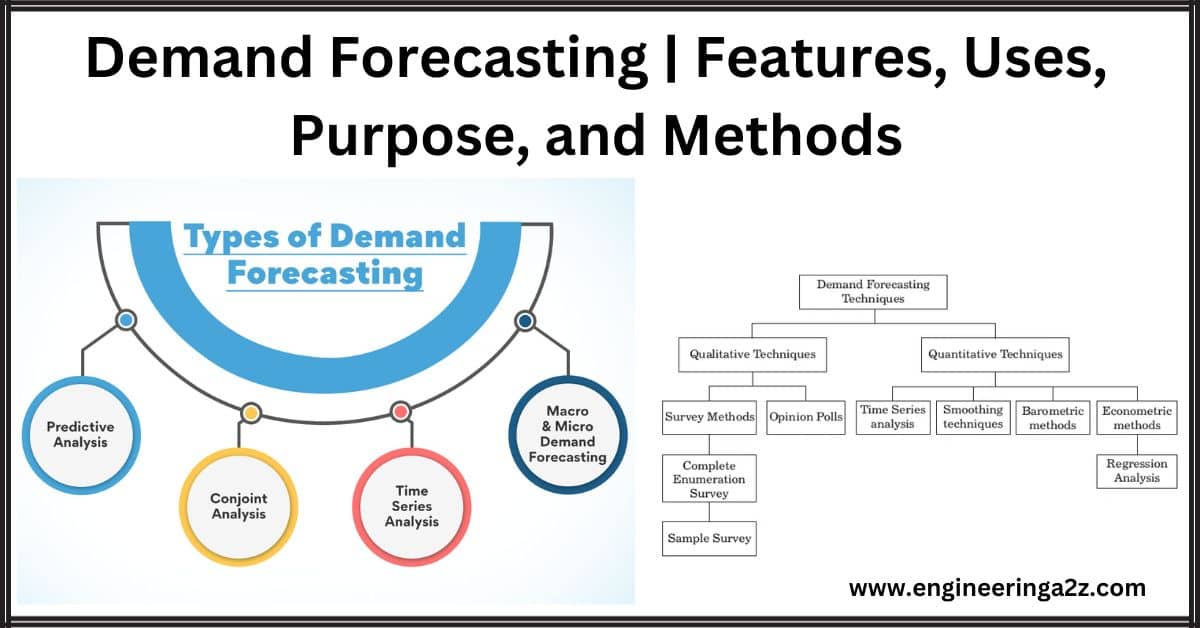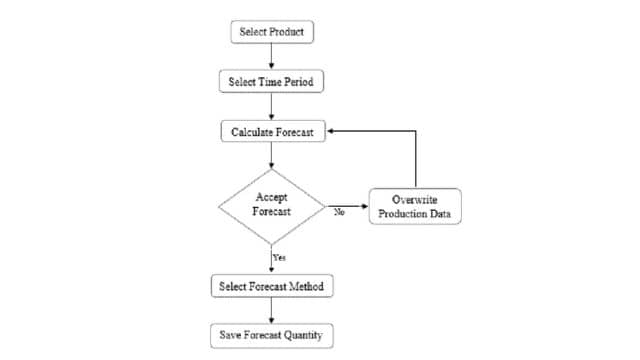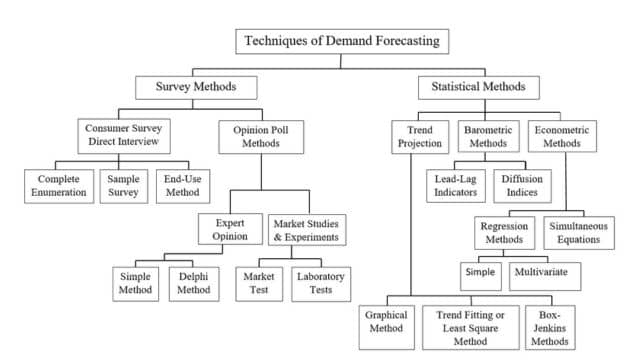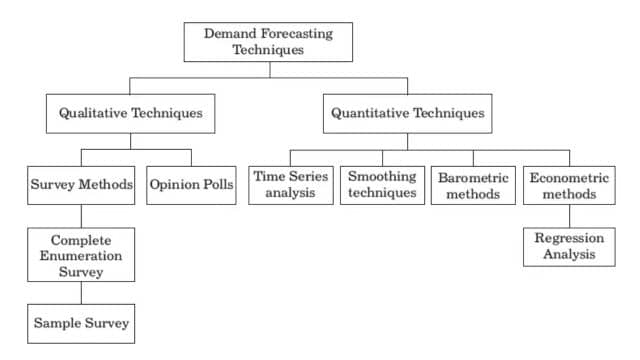
Table of Contents
A forecast, particularly in the context of demand forecasting, is a prediction or estimation of a future event that is most likely to happen under given conditions. In a world in which future outcomes are rarely assured, the formation of some view, explicit or implicit, about the future is inevitable. This view may be optimistic, pessimistic, or based on hunches. Forecasts, especially those related to demand forecasting, can be both physical as well as financial in nature and are used mostly for planning.
Meaning of Demand Forecasting
Demand forecasting refers to the prediction of the probable demand for a good or service on the basis of past events and the prevailing trends in the present. In other words, it tells the expected level of demand at some future date by considering the past and present behavior patterns of the related events. Thus, demand forecasting means when, how, where, and how much will be the demand for a product or service in the near future. Since ‘demand forecasting’ is also known as ‘sales forecasting”, therefore some writers have defined sales forecasting.
Definition of Demand Forecasting
According to Cundiff and Still, “Demand forecasting is an estimate of demand during a specified period. Which estimate is tied to a proposed marketing plan and which assumes a particular set of uncontrollable and competitive forces” Thus, the process of forecasting demand or sales may, therefore, be broken into two parts, namely, analysis of the past conditions and analysis of current conditions with reference to a probable future tendency.

Features of Demand Forecasting
Demand forecasting is about predicting future sales or demand for products. Here are some key points about it:
- It’s about figuring out how much of a product people will want to buy in a specific time period.
- This prediction can be in terms of money or the number of items.
- It’s essential for planning how much to produce.
- It’s like making an educated guess about future sales based on past trends and current economic conditions.
- Businesses do it to make decisions about things like market strategy and investments.
- It helps in planning for the right kind of skilled workers.
- It also guides decisions about advertising and sales campaigns.
Usefulness of Forecasting
The uses of demand forecasting are as under.
(1) To Produce the Required Quantity: Accurate demand forecasting is essential for a firm to be able to produce the required quantities at the right time and arrange well in advance for the various actors of production namely raw material, equipment, machine accessories, labor, building, etc. Some Timms may as a policy produce to order but, generally, firms produce in anticipation of future demand.
(2) To Assess Probable Demand: Forecasting helps a firm to assess the probable demand for its product and plan its production accordingly. It is an important aid in effective and efficient planning It can also help management in reducing its dependence on chance.
(3) Investment and Employment: Forecasting helps in the planning of long-term investment programs as well as in the stabilization of aggregate employment with a view to satisfying organized labor and pacifying public opinion.
(4) Team Work: Good forecasting calls for teamwork among such departments as general business research and market research, sales, production, planning, accounting, and finance.
(5) Help to the Government: At the macro level, demand forecast may help the government determine whether imports are necessary to meet any possible deficit in the domestic supply, or devise appropriate export promotion policies if there is a surplus.

Purpose of Demand Forecasting
Short-term forecasting (covering a few months to a year) and long-term forecasting (spanning 5, 10, or even 20 years) serve different purposes in business:
Short-term Forecasting (Purpose):
- Helps in scheduling production to avoid over-production or shortages.
- Assists in controlling costs related to raw materials and inventory.
- Guides the setting of prices to maintain consistent sales.
- Establishes sales targets, controls, and incentives based on changing demand patterns and competition.
- Shapes advertising and promotion strategies.
- Forecasts short-term financial needs.
Long-term Forecasting (Purpose):
- Informs the planning of new business units or expanding existing ones, considering long-term demand for products.
- Assesses long-term financial requirements, crucial for raising funds.
- Anticipates future manpower needs, especially as production techniques evolve.
- Helps develop a strategy to produce goods that align with changing societal needs.
In essence, short-term forecasting focuses on immediate business needs, such as production scheduling and cost control, while long-term forecasting is more about strategic planning for expansion, financial planning, workforce development, and adapting to evolving market demands.
Steps Involved in Demand Forecasting
For an efficient, accurate, and meaningful forecast of demand, the following steps are necessary.
(1) Identification of Objective: It is necessary to be clear about what one wants to get from the forecast. The purpose of the exercise may be the estimation of one or more aspects, like the quantity and composition of demand, price to be quoted, sales planning, inventory control, etc. The approach to the problem will accordingly differ.
(2) Determining the Nature of Goods: Different category of goods such as consumer and capital goods, durable and non-durable goods, existing goods and new goods, etc. have their own distinctive demand pattern is, therefore, necessary to determine the class in which the good falls. This will help us in identifying the approach of the forecast exercise.
(3) Selection of Proper Method: The selection of an appropriate method of forecasting is related to the objective of forecasting, the type of data available, the availability of trained personnel, and the period for which the forecast is to be made. Then different methods may be required for short-term and long-term forecasting
(4) Interpretation of Results: The efficiency of a forecast depends, to a large extent, upon the efficiency in the interpretation of its results. Most of the time the forecast results are to be well supported by the background factors (like the government policy, general business environment, international economic, political, and social scene, etc.) that have not entered the exercise of forecasting. Further, we need to frequently revise the forecast in light of changing circumstances because forecasts are, in the instance, made on the assumption of the continuation of past events.
Determining Scope of Demand Forecasting
Before you start a forecasting task, you need to consider several important factors to determine the scope of the exercise:
- Period of Forecast:
- Short-run forecasting: Typically up to 3 months, focusing on factors like weather, trends, and immediate demand fluctuations.
- Medium-term forecasting: Covers 3 months to one year, relying more on experience and judgment for decisions like timing and advertising.
- Long-run forecasting: Extends beyond one year and guides major strategic decisions, considering factors like structural changes, government policies, and economic shifts.
- Levels of Forecasting:
- Macroeconomic forecasting: Examines overall economic conditions using indicators like national income and production.
- Industry demand forecasting: Predicts industry-wide trends and behavior, often provided by trade associations.
- Firm demand forecasting: Tailored to a specific company, helping it assess its position against competitors.
- Product-line forecasting: Assists in resource allocation among a company’s product offerings.
- General Purpose or Specific Purpose Forecasts:
- Breaking down general forecasts into specific ones related to commodities, sales areas, domestic vs. export markets, etc., can provide more useful insights.
- Forecasts of Established or New Products:
- Established products rely on past sales trends and competitive conditions, whereas new products lack historical data.
- Type of Commodity for Forecasting:
- Different categories like capital goods, consumer durables, and non-durable goods require distinct forecasting approaches due to their unique demand patterns.
- Inclusion of Miscellaneous Factors:
- The forecaster must decide how sociological and psychological factors, product and market characteristics, competition, uncertainty, population changes, income distribution, and errors will influence the accuracy in forecasting exercise.
In essence, when embarking on a forecasting task, you need to determine the timeframe, level of analysis, specific vs. general focus, product type, and whether to consider various influencing factors. These considerations will shape the scope and approach of your forecasting exercise.
Methods of Demand Forecasting
Predicting the future of a business is not easy, and there’s no one-size-fits-all method. Various forecasting techniques exist, each with its level of accuracy and complexity. The key is to choose the most suitable method based on your goals, available data, resources, and expertise. A combination of judgment and scientific methods is often the best approach. Here are some common demand forecasting techniques:
- Opinion Polling Methods:
- Collecting opinions from buyers, salespeople, and experts to understand market trends.
- Consumers’ Survey: Gathering intentions of potential buyers through interviews or surveys about factors like price changes, advertising, and quality.
- Complete Enumeration Survey: Contacting all potential consumers for accurate data, but it’s time-consuming and costly.
- Sample Survey: Interviewing a smaller group to estimate overall demand, which is less time-consuming but can be expensive and less accurate.
- Collective Opinion Method (Sales-force Opinion): Consulting salespeople for sales estimates, considering their proximity to customers and firsthand knowledge. Adjusting estimates for factors like price changes, product design, and market conditions.
- Experts’ Opinion Method:
- Seeking views from specialists or experts in the field who understand market trends and consumer behavior.
- Using the ‘Delphi Method,’ where experts’ opinions are collected anonymously, exchanged, and refined until a consensus is reached.
- Suitable for situations with significant changes and offers speed and cost-effectiveness.
- Statistical Methods:
- Utilizing statistical techniques for forecasting demand.
- Trend Projection Method (Time Series Analysis): Examining historical data, such as sales over the past years, to identify trends. Extrapolating these trends into the future.
- Graphic Method: Creating a trend line through a graphical representation of data points, showing the general trend over time.
These methods have their pros and cons:
- Opinion-based methods are simple and rely on firsthand knowledge but may lack objectivity and are best suited for short-term forecasts.
- Expert opinions can be valuable but may not consider broader economic changes.
- Statistical methods provide objective forecasts based on historical data but require statistical expertise and may not account for sudden changes.
In summary, the choice of forecasting method should align with your specific needs and resources, combining judgment and scientific techniques to predict future product demand effectively.

Criteria of a Good Forecasting Method
When choosing a suitable forecasting method, consider the following criteria:
- Accuracy: Check the accuracy of past forecasts compared to actual results and how well present forecasts align with future outcomes. Look at the degree of deviation between forecasts and reality and the success in predicting directional changes.
- Simplicity: The chosen method should be easy for the firm to understand and have confidence in. If the forecasting technique is too complex and the team doesn’t grasp it, it can lead to misinterpretation of results.
- Economy: Weigh the costs of forecasting against its importance to the business. Find the right balance between the benefits of increased accuracy and the extra cost of improving forecasting.
- Availability: Ensure that the chosen techniques are capable of producing meaningful results quickly and are readily available and well-understood within the organization. It’s not just about what’s achievable but also what can be effectively understood and applied.
- Timeliness: Recognize that there’s a time gap between an event and its forecast, known as “lead time.” Longer lead times provide more useful forecasts, so prioritize having a lead time, even if it means sacrificing a bit of accuracy.
- Effectiveness: A good forecast doesn’t just identify existing trends; it should also predict deviations and turning points to be truly effective.
In essence, when selecting a forecasting method, consider accuracy, simplicity, cost, availability, lead time, and the ability to predict changes effectively. This will help you choose the most suitable method for your business needs.
Frequently Asked Questions (FAQs)
What is Demand forecasting?
Demand forecasting predicts future customer demand for products or services. It’s crucial for businesses to plan production, manage resources, and make informed decisions about inventory, pricing, and marketing strategies.
What are demand forecasting examples?
Examples of demand forecasting include predicting smartphone sales for the next quarter, estimating holiday season toy demand, and forecasting energy consumption for a city.
What are the three types of forecasting?
The three types of forecasting are:
1. Qualitative Forecasting: Based on expert opinions and judgment.
2. Time Series Analysis: Uses historical data to identify patterns.
3. Causal Models: Considers cause-and-effect relationships.
Read Also:
- Comparison Between Microeconomics and Macroeconomics
- Globalisation | Impacts of Globalisation
- Economics For Engineers Book PDF
- Supply : Law of Supply
- Markets: Perfect competition, Monopoly, Monopolistic & Oligopoly
- Marketing Management | Objectives & Functions of Marketing Management






Leave a Reply